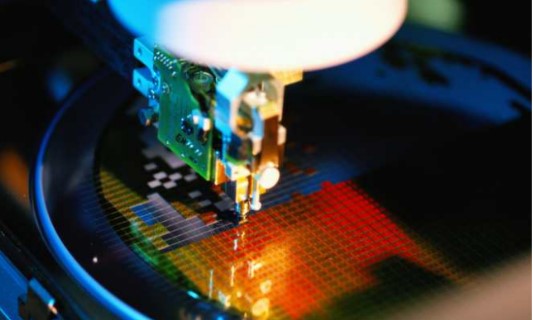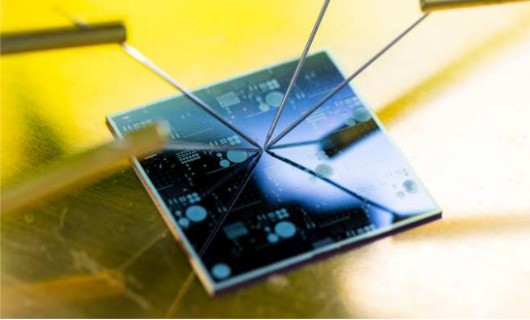Over the past decade, semiconductor industries in India has emerged as a force to be reckoned with, showcasing remarkable growth and setting its sights on a promising future in the global market. From advancements in technology to strategic collaborations and substantial investments, the nation’s semiconductor sector has come a long way. This article delves into the evolution of semiconductor industries in India and the key factors that have propelled its growth.
The Driving Forces behind India’s Semiconductor Industry Growth
The growth of semiconductor industries in India can be attributed to a confluence of factors that have collectively shaped its trajectory.
1. Demand Surge and Technological Transformation:
The widespread adoption of transformative technologies like AI, IoT, and ML has led to an insatiable demand for semiconductors worldwide. India, recognizing the potential of these technologies, has actively invested in developing its semiconductor capabilities to meet global demand.
2. Government Initiatives:
According to India Briefing, the Indian government’s proactive stance has played a pivotal role in fostering semiconductor growth. Initiatives like the ‘Make in India’ campaign, the India Semiconductor Mission (ISM), and various incentive schemes have incentivized domestic and foreign companies to establish manufacturing facilities in India. These initiatives have created a conducive environment for growth and innovation in the semiconductor sector.
3. Collaborative International Partnerships:
India Briefing says collaboration with global players, especially the United States, has been instrumental in India’s semiconductor journey. The iCET initiative, launched in partnership with the Semiconductor Industry Association (SIA) and the India Electronics Semiconductor Association (IESA), highlights India’s commitment to bolster its semiconductor industry through international cooperation.
4. Skilled Workforce and Education:
India’s robust education system and a vast pool of highly skilled semiconductor design engineers have played a crucial role. Indian engineers, contributing significantly to chip development across various stages, have solidified India’s position as a global semiconductor hub.
5. Strategic Investments:
India’s commitment to its semiconductor future is demonstrated by its substantial financial investments. Allocating significant funds to semiconductor-related industries, such as electronics manufacturing, solar photovoltaic cells, and electric vehicles, showcases India’s determination to drive semiconductor demand and innovation.
6. Environmental Consciousness:
India’s focus on sustainability and clean energy aligns with global trends, making its semiconductor industry an attractive option for companies seeking environmentally conscious manufacturing processes. The emphasis on solar photovoltaic cells and electric vehicles not only addresses environmental concerns but also contributes to the overall attractiveness of the Indian semiconductor ecosystem.
India’s Journey to Semiconductor Supremacy: Challenges, Strategies, and Prospects
As the global semiconductor industry continues to thrive, India is steadfastly positioning itself as a major player in both semiconductor manufacturing and design. However, this pursuit comes with its set of challenges and strategic moves.
Rising to the Challenge
India’s semiconductor journey started decades ago, but it was only recently that the nation began to earnestly set its sights on becoming a semiconductor hub. With an anticipated consumption of semiconductors poised to skyrocket, India recognizes the need for self-reliance in chip production. Despite a strong talent pool in chip design, the country lacks domestic manufacturing capabilities.
Strategic Policy Framework
According to a report by MeitY, India’s National Policy on Electronics 2019 (NPE 2019) aims to position the country as a global hub for Electronics System Design and Manufacturing (ESDM). Several key policy initiatives have been launched to incentivize and catalyse growth:
1. Scheme for Promotion of Manufacturing of Electric Components and Semiconductors (SPECS), 2020: This scheme offsets manufacturing disabilities, fostering a robust electronic manufacturing ecosystem.
2. Modified Program for Semiconductors and Display Fab Ecosystem, 2021: The government offers substantial incentives to encourage the development of semiconductor and display manufacturing ecosystems.
3. India Semiconductor Mission (ISM): A specialized mission to drive long-term strategies for sustainable semiconductor and display ecosystems.
4. Gujarat Semiconductor Policy 2022-27: The state of Gujarat is striving to create a conducive environment for the ESDM sector through specialized industrial zones and infrastructure support.
Advantages:
1. Talent Pool: India boasts strong design and engineering talent, attracting global semiconductor design companies to establish R&D centers in the country.
2. Policy Support: Government initiatives provide financial incentives, infrastructure support, and a clear vision for semiconductor growth.
3. Strategic Alliances: Collaborations with industry giants, such as the US Semiconductor Industry Association, strengthen India’s semiconductor ecosystem.
4. Cluster-Based Ecosystems: Developing semiconductor clusters enhances collaboration, efficiency, and access to skilled talent.

Challenges:
1. Lack of Manufacturing Infrastructure: While India excels in chip design, the country faces challenges in building chip fabrication facilities.
2. Capital Intensity: The semiconductor industry requires substantial investments, deterring smaller players from entering the field.
3. Resource Constraints: The industry demands ultra-pure water, stable power supply, and specialized gases and wafers, areas where India faces limitations.
4. Long Gestation Period: Chip manufacturing is high-risk with a lengthy gestation period, making it a challenging investment.
Charting the Course Forward
India’s quest for semiconductor supremacy is a multi-faceted endeavour. Building on its existing strengths in chip design, the country is actively courting foreign investment to bolster manufacturing capabilities. Policymakers are focused on creating supportive ecosystems, incentivizing research and development, and fostering strategic partnerships. As India addresses challenges in infrastructure, resources, and expertise, its trajectory toward becoming a global semiconductor powerhouse gains momentum. By aligning its policies, talent, and strategic partnerships, India is carving a path to reshape the semiconductor landscape, contributing to a more resilient global supply chain.
Government Initiatives Accelerating India’s Ascent in Semiconductor Industry
India is a large semiconductor market estimated to be valued at USD 27 billion in 2022 and is expected to grow at 20% CAGR over the next few years. The market is largely served by imports with only a few elements of the semiconductor supply value chain being represented in India – design, testing, verification & validation, reported The Economic Times.
Driving Ambitions with Incentives
The cornerstone of India’s semiconductor journey is the ambitious Semiconductor Incentive Scheme, which aims to make India a preferred destination for semiconductor manufacturing and design. Under this scheme, companies are offered attractive capital and interest subsidies, tax benefits, and support for research and development. This not only encourages domestic companies but also entices international players to set up or expand their operations in India.
Fostering Research and Development
Recognizing that innovation is the lifeblood of the semiconductor industry, the government has established R&D and Incubator Centers exclusively for semiconductors. These centers facilitate collaboration between academia and industry, fostering cutting-edge research and accelerating the development of indigenous technologies. This emphasis on research not only enhances India’s capabilities but also strengthens its position as a global contributor to semiconductor advancements.
Design Linked Incentive Scheme
To encourage homegrown innovation, India introduced the Design Linked Incentive (DLI) Scheme. This initiative nurtures semiconductor startups by providing incentives for chip design infrastructure, product design, and deployment. By offering financial support and expertise, the government is helping these startups create innovative solutions for both domestic and international markets.
Collaboration with Global Leaders
Recognizing the value of international collaboration, India has formed partnerships with semiconductor giants. Collaborative efforts with the United States, Japan, and Australia aim to secure semiconductor supply chains, develop talent, and enhance the resilience of the industry. These alliances position India as a key player in the global semiconductor ecosystem.
Investing in Skill Development
A skilled workforce is essential for the growth of the semiconductor industry. To address this need, India is investing in programs that train and develop semiconductor professionals. These initiatives not only meet the industry’s demand for skilled talent but also create employment opportunities for a burgeoning youth population.
Challenges and Future Prospects
While India’s semiconductor ambitions hold promise, challenges remain. The country needs to streamline bureaucratic processes, strengthen intellectual property protection, and ensure a favourable environment for technology transfer. Furthermore, addressing infrastructural constraints and cost disparities will be crucial to attracting significant investments.
Ecosystem Development: Nurturing India’s Semiconductor Future
The rapid advancement of technology in the 21st century has led to an increasing reliance on semiconductors, the building blocks of modern electronics. From smartphones to autonomous vehicles, semiconductors play a pivotal role in shaping the way we live and work. Recognizing the importance of a self-reliant semiconductor industry, India has embarked on a journey to create a robust ecosystem that supports semiconductor research, innovation, and skill development.
Digital India and Beyond
India’s push towards digitalization and technological self-sufficiency received a significant boost with the launch of the Digital India program in 2015. Spearheaded by Prime Minister Narendra Modi, this initiative aimed to transform India into a digitally empowered society by enhancing digital access, inclusion, and services across the country. The subsequent emphasis on technology-led innovation, along with the push for a manufacturing-friendly environment through initiatives like ‘Make in India,’ set the stage for a more holistic approach to ecosystem development, reported PIB.
Driving Skill Development
One of the key challenges in establishing a thriving semiconductor ecosystem is the shortage of skilled manpower. The Indian government, recognizing this critical need, has taken several measures to bridge the gap. The ‘Skill India Mission,’ launched in 2015, focuses on training and upskilling the workforce to meet the demands of emerging industries like semiconductors. Initiatives such as ‘Chips to System Design’ and ‘Chips to Startup’ promote academic development in the semiconductor sector, creating a pipeline of skilled professionals.
Collaboration between Industry and Academia
A strong collaboration between industry and academia is a cornerstone of ecosystem development. Indian semiconductor companies have been actively partnering with academic institutions to drive research and development. These partnerships enable the exchange of knowledge, promote joint projects, and provide students with valuable exposure to real-world challenges. The signing of a Memorandum of Understanding (MoU) between the Indian Semiconductor Mission and Purdue University exemplifies the commitment to collaboration and capacity building.
Supportive Policies and Incentives
The Indian government’s policies and incentives have played a pivotal role in creating an enabling environment for semiconductor innovation. The ‘Production Linked Incentive’ scheme for the electronics sector, including semiconductor manufacturing, offers substantial incentives to companies establishing semiconductor production facilities in India. These incentives attract foreign investment and stimulate indigenous innovation, bolstering the growth of the semiconductor industry.
OpalForce’s Contribution
Private entities have also recognized the importance of contributing to ecosystem development. OpalForce, an AI and Semiconductor Solutions company, has taken proactive steps to address the talent shortage by establishing the OpalSemi Academy. Through targeted training and mentorship, the academy aims to nurture a pool of skilled chip design engineers, aligning with the nation’s aspirations to become a semiconductor design and innovation hub.

The Path Ahead
As India moves forward, the roadmap for semiconductor ecosystem development becomes clearer. The focus on skill development, collaboration between academia and industry, supportive policies, and private sector initiatives collectively form the pillars of this ecosystem. The semiconductor industry is poised to shape India’s technological progress on the global stage.
The strides made in semiconductor research, innovation, and skill development are not just building blocks for the industry’s growth; they are pivotal to India’s journey towards becoming a technology leader. With visionary leadership, concerted efforts from government, academia, and industry, and a commitment to nurturing talent, India’s semiconductor ecosystem is set to thrive, paving the way for a technologically empowered future.
Fostering India’s Semiconductor Industry: Milestones and Collaborations Shaping the Future
India’s determined efforts to establish itself as a significant player in the global semiconductor industry have gained substantial momentum. The semiconductor sector has not only emerged as a cornerstone of technological progress but also as a catalyst for economic growth and self-reliance. Several key players are instrumental in driving this growth, achieving remarkable milestones, and forging critical collaborations that are propelling India’s ascendancy in the semiconductor domain.
Domestic Powerhouses:
1. Advanced Micro Devices (AMD): AMD, a globally recognized semiconductor giant, has significantly invested in India, pledging up to $400 million over the next five years. This substantial commitment reflects AMD’s trust in India’s semiconductor ecosystem and emphasizes its belief in the country’s potential to drive semiconductor innovation. This investment is pivotal not just for bolstering India’s manufacturing capabilities but also for fostering indigenous research and development. (Source: Reuters)
2. Sahasra: As an outsourced semiconductor assembly and test company, Sahasra plays a pivotal role in India’s semiconductor landscape. By providing assembly and packaging services for chips, Sahasra contributes to the manufacturing process of various semiconductor products, aiding both local and global semiconductor companies in delivering efficient and reliable products to the market.
3. Indian Institute of Technology (IIT) Institutions: Renowned academic institutions like IIT Bombay, IIT Madras, BITS Pilani, Ganpat University, and Nirma University have emerged as hubs for semiconductor research, innovation, and education. These institutions are nurturing the next generation of semiconductor engineers and researchers while collaborating with industry players and the government to foster the growth of indigenous semiconductor technologies.

Industry Collaborations and Alliances:
1. Vedanta Group and Foxconn: The partnership between Vedanta Group and Foxconn for semiconductor manufacturing showcases India’s ambition to become a significant electronics industry player. With plans to invest $19.5 billion in Gujarat for semiconductor and display production facilities, this collaboration aims to produce affordable electronics like smartphones, laptops, televisions, and electric vehicles, addressing the burgeoning demand in the Indian market. (Source: Hindustan Times)
2. SRAM & MRAM Group: The Indian arm of SRAM & MRAM Group has inked agreements with the Odisha government to establish semiconductor fabrication facilities. This strategic move not only creates job opportunities but also contributes to the production of memory chips for various electronic devices, reported Moneycontrol.
3. Global Giants’ Interest: Industry titans like TSMC, TMH Group, and Foxconn are considering setting up semiconductor fabrication lines in India. Their potential investments highlight India’s growing appeal as a semiconductor manufacturing hub, further bolstering the nation’s pursuit of self-reliance in semiconductor production.
International Collaborations and Alliances:
1. India-US Semiconductor Collaboration: The memorandum of understanding (MoU) signed between India and the US focuses on establishing a collaborative mechanism for semiconductor supply chain resiliency and diversification. This collaboration acknowledges India’s potential as a future partner in building a resilient supply chain, addressing the global overdependence on a few countries for semiconductor supply. (Source: The Hindu)
2. India-Japan Semiconductor Collaboration: The collaboration between India and Japan in the semiconductor sector aims to create a more resilient supply chain and work jointly on developing the semiconductor ecosystem. The partnership focuses on semiconductor design, manufacturing, equipment research, supply chain resilience, and talent development. This collaboration leverages India’s strengths in chip design and packaging and aligns with Japan’s expertise in chip manufacturing. (Source: The Hindu)
India’s Semiconductor Boom: Impact on other Sectors
The semiconductor industries in India is standing at the precipice of transformation, propelled by ambitious visions and promising opportunities. According to Times of India, Prime Minister Narendra Modi’s recent announcement to nurture a talent pool of skilled chip design engineers has set the stage for India to emerge as a global semiconductor design and innovation hub. As the nation rallies behind this vision, OpalForce, an AI and Semiconductor Solutions company, has taken up the mantle to lead this transformation. In the wake of this revolution, the impact of India’s semiconductor growth reverberates across multiple sectors beyond electronics, notably in the automotive, healthcare, and telecommunications industries.
Revolutionizing Automotive Sector
The automotive industry is undergoing a profound revolution, with semiconductors at its core. Modern vehicles are not merely machines; they are complex networks of interconnected systems, driven by semiconductors that power everything from advanced driver assistance systems (ADAS) to infotainment and electrification. India’s burgeoning semiconductor ecosystem is playing a pivotal role in redefining the automotive landscape:
1. Electrification and Autonomous Driving: Semiconductors are the bedrock of electric vehicles (EVs) and autonomous driving. With India’s push towards electric mobility, domestic semiconductor capabilities are crucial for developing EV powertrains, battery management systems, and autonomous vehicle technologies.
2. Enhanced Safety: Semiconductors enable cutting-edge safety features such as collision avoidance, adaptive cruise control, and automated emergency braking, making Indian roads safer for all.
3. Infotainment and Connectivity: India’s semiconductor growth is driving the integration of advanced infotainment systems, connecting vehicles to the digital world, enhancing passenger experiences, and creating opportunities for in-car services.
Empowering Healthcare Innovations
The healthcare sector is also benefiting from India’s semiconductor prowess. Semiconductor-enabled medical devices are becoming instrumental in diagnosis, treatment, and patient care:
1. Diagnostic Equipment: Medical imaging technologies like MRI, CT scans, and ultrasound heavily rely on semiconductors to capture, process, and display high-quality images for accurate diagnosis.
2. Telemedicine and Wearable: The growth of semiconductors supports the expansion of telemedicine and wearable health devices, allowing remote monitoring and real-time health data analysis.
3. Medical Research and Drug Development: High-performance computing enabled by semiconductors accelerates complex simulations, genomics research, and drug discovery processes.
Revolutionizing Telecommunications
The telecommunications sector is undergoing a seismic shift with the advent of 5G technology. India’s semiconductor growth is fostering innovation and expansion in this crucial domain:
1. 5G Deployment: Semiconductors are the backbone of 5G infrastructure, enabling faster data transfer rates, low latency, and massive device connectivity. India’s semiconductor capabilities are pivotal in establishing a robust 5G network.
2. Internet of Things (IoT): 5G and IoT are intertwined, with semiconductors enabling seamless communication between devices. As India embraces IoT solutions, its semiconductor industry becomes central to driving IoT adoption across industries.
3. Network Efficiency and Reliability: Advanced semiconductor solutions are essential for developing network equipment that ensures seamless connectivity, higher bandwidth, and reduced downtime.
Sustainability and Innovation: Transformation in India’s Semiconductor Industry
Semiconductor fabrication facilities, intricate hubs of technology, are known for their heavy water and power consumption, emissions of toxic chemicals, and massive carbon footprints. However, as India embarks on its journey to establish capital-intensive semiconductor facilities, it has a unique opportunity to showcase sustainable manufacturing practices while driving technological advancement. With the establishment of the Indian Semiconductor Mission (ISM) and leveraging the expertise of the Indian diaspora in high-tech fields, India can weave sustainability into its semiconductor industry’s fabric, setting an example for the world. (Source: https://ism.gov.in/)
1. Integrating Sustainability into Policy
India’s commitment to creating sustainable semiconductor facilities is reflected in its policies. ISM provides a platform to knit sustainability into the fabric of the industry. Policies could include:
Skill Development: Focusing on sustainability-oriented skills in the workforce, ensuring a well-prepared talent pool.
Incentives for R&D: Encouraging innovation and research in environmentally-friendly technologies, fostering greener chip manufacturing.
Regulatory Alignment: Ensuring regulations promote sustainability without hindering technological advancement.
2. Greening Processes with Technology
The energy-intensive nature of fabrication can be addressed through technology integration:
Renewable Energy: Incorporating renewable energy sources like solar and wind to power facilities, reducing the carbon footprint.
Energy Efficiency: Improving energy efficiency through advanced technologies, reducing power consumption.
Water Management: Implementing recycling techniques to minimize water usage, decreasing environmental impact.
Waste Management: Embracing sustainable waste management practices for safe disposal of hazardous waste.

3. Harnessing Emerging Technologies
The semiconductor industry’s future lies in the integration of emerging technologies:
AI, IoT, and Robotics: Leveraging AI, IoT, and robotics to streamline manufacturing processes, reducing resource consumption and downtime.
Supply Chain Resilience: Building responsible supply chains with indigenous content to mitigate disruptions.
Greener Materials: Investing in research for environmentally-friendly materials and their adoption in chip manufacturing.
4. Collaborative Efforts and ESG Focus
Industry Initiatives: Collaboration through industry associations like SEMI’s Semiconductor Climate Consortium emphasizes the industry’s commitment to addressing climate change.
Committee for ESG: Establishing a committee under ISM for Environmental, Social, and Governance (ESG) concerns to guide sustainable practices.
5. Policy Support for Startups
Nurturing Startups: Providing support to chip design startups through policies and incentives, fostering innovation in the industry.
Government Backing: Government support plays a pivotal role in nurturing innovation and growth, creating a conducive ecosystem for startups.
6. Academic and Industrial Collaboration
India Semiconductor Research Centre (ISRC): Establishing a world-class research institution driving innovation in advanced semiconductor and packaging technologies.
Collaborative Problem-Solving: Collaborating across academia and industry to tackle complex challenges, fostering innovation.
7. Embracing Sustainability as a Key Component
Building a Sustainable Ecosystem: Recognizing the capital-intensive nature of the industry, investing in infrastructure, technology, and human resources to ensure success.
Supply Chain Sustainability: Embracing sustainable supply chain practices, shifting towards environmentally-friendly practices in global semiconductor manufacturing.
Semiconductor Industries in India is at a pivotal juncture, and the nation’s approach to sustainability could set a global benchmark. By weaving sustainability into policies, processes, and innovation, Indian semiconductor companies can pave the way for a greener future. As India takes on the mantle of the G20 Presidency and strives to become a prominent “Semiconductor Nation,” it has the opportunity to lead by example, showcasing that technological advancement and environmental responsibility can go hand in hand. With collaborative efforts, forward-thinking policies, and innovative practices, Indian semiconductor companies can contribute to a more sustainable and resilient global technology landscape. (Source: Business Today)
Market Trends: Emerging Niche Segments in India’s Thriving Semiconductor Industry
Semiconductor Industries in India is undergoing a transformative phase, propelled by a convergence of factors such as government initiatives, technological advancements, and global demand. With its ‘Make in India’ campaign and the National Electronics Policy, the country is setting the stage for a robust semiconductor ecosystem. As the industry continues to evolve, several emerging niche segments are gaining traction, shaping the landscape and driving innovation.
1. Semiconductor Manufacturing Facilities:
A significant trend in Semiconductor Industries in India is the establishment of new manufacturing facilities. The government’s support, including the Production-Linked Incentive (PLI) scheme and incentives for fabrication capacities, has incentivized companies to set up semiconductor fabs, especially in the compound semiconductors, silicon photonics, sensors, and discrete semiconductors domains. This surge in manufacturing facilities is expected to enhance India’s self-reliance and reduce dependency on chip imports. (Source: PIB)
2. Advanced Packaging and Testing:
While the focus often remains on chip design and manufacturing, advanced packaging and testing are emerging as vital segments. Companies like Sahasra and Micron are investing in semiconductor assembly and testing facilities, contributing to the industry’s growth. The demand for packaging solutions that enhance performance, reliability, and miniaturization is driving innovation in this niche segment.
3. AI-Related Semiconductor Components:
India’s pool of skilled AI professionals and increasing investments in AI research and development are fueling demand for AI-related semiconductor components. As artificial intelligence continues to shape various industries, specialized chips optimized for AI workloads are gaining prominence. The intersection of AI and semiconductors presents an opportunity for India to tap into this evolving market.
4. Compound Semiconductors and Silicon Photonics:
The modification of the Program for Development of Semiconductors and Display Manufacturing Ecosystem in India reflects a growing focus on compound semiconductors, silicon photonics, sensors, and discrete semiconductors. These advanced materials and technologies offer improved performance, higher speeds, and energy efficiency, making them crucial for applications in 5G networks, data centers, and emerging technologies.
5. Display Fabs and Optoelectronics:
The demand for high-quality displays for smartphones, laptops, TVs, and other devices is driving investments in display fabs and optoelectronics. With the push for local manufacturing, India aims to become a global hub for display production. The modified program’s incentives for display fabs signify the industry’s acknowledgment of this niche’s potential.
6. Electric Vehicles (EVs) and Automotive Electronics:
As the world transitions toward electric mobility, semiconductor-enabled innovations in EVs are gaining momentum. Semiconductors play a crucial role in electric vehicle powertrains, battery management, and vehicle connectivity. The growth of the electric vehicle market is propelling the demand for automotive semiconductors, creating a niche segment with significant growth prospects.
7. Semiconductor Design Startups:
India’s semiconductor landscape is also witnessing the emergence of startups focusing on semiconductor design. The Design-Linked Incentive (DLI) Scheme, part of the larger Program for Development of Semiconductors, is nurturing these startups by offering financial incentives and design infrastructure support. This trend is fostering a culture of innovation and entrepreneurship within the industry.
8. Collaborative Initiatives and Partnerships:
International collaborations and partnerships are crucial for India’s semiconductor industry to stay competitive globally. Initiatives like the joint mechanism between India and Japan, as well as potential partnerships with companies like GlobalFoundries and STMicroelectronics, underscore the significance of cross-border cooperation in technology transfer, talent development, and supply chain resilience.
In conclusion, India’s semiconductor industry is witnessing dynamic shifts driven by government policies, technological advancements, and global trends. The emergence of niche segments such as compound semiconductors, AI-related components, advanced packaging, and EV electronics reflects the industry’s adaptability and potential for innovation. As India continues to work toward becoming a global semiconductor hub, these trends signal a promising future for the country’s role in shaping the semiconductor landscape.














